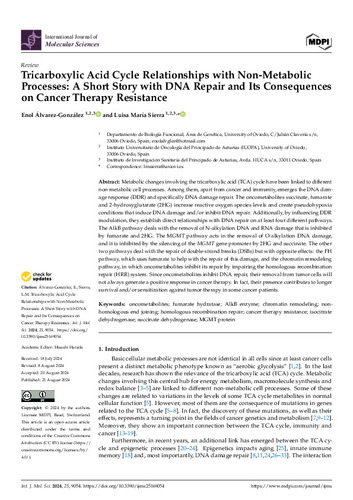Tricarboxylic Acid Cycle Relationships with Non-Metabolic Processes: A Short Story with DNA Repair and Its Consequences on Cancer Therapy Resistance.
Subject:
oncometabolites; fumarate hydratase; AlkB enzyme; chromatin remodeling; non- homologous end joining; homologous recombination repair; cancer therapy resistance; isocitrate dehydrogenase; succinate dehydrogenase; MGMT protein
Publication date:
Publisher version:
Citación:
Abstract:
Metabolic changes involving the tricarboxylic acid (TCA) cycle have been linked to different non-metabolic cell processes. Among them, apart from cancer and immunity, emerges the DNA dam- age response (DDR) and specifically DNA damage repair. The oncometabolites succinate, fumarate and 2-hydroxyglutarate (2HG) increase reactive oxygen species levels and create pseudohypoxia conditions that induce DNA damage and/or inhibit DNA repair. Additionally, by influencing DDR modulation, they establish direct relationships with DNA repair on at least four different pathways. The AlkB pathway deals with the removal of N-alkylation DNA and RNA damage that is inhibited by fumarate and 2HG. The MGMT pathway acts in the removal of O-alkylation DNA damage, and it is inhibited by the silencing of the MGMT gene promoter by 2HG and succinate. The other two pathways deal with the repair of double-strand breaks (DSBs) but with opposite effects: the FH pathway, which uses fumarate to help with the repair of this damage, and the chromatin remodeling pathway, in which oncometabolites inhibit its repair by impairing the homologous recombination repair (HRR) system. Since oncometabolites inhibit DNA repair, their removal from tumor cells will not always generate a positive response in cancer therapy. In fact, their presence contributes to longer survival and/or sensitization against tumor therapy in some cancer patients.
Metabolic changes involving the tricarboxylic acid (TCA) cycle have been linked to different non-metabolic cell processes. Among them, apart from cancer and immunity, emerges the DNA dam- age response (DDR) and specifically DNA damage repair. The oncometabolites succinate, fumarate and 2-hydroxyglutarate (2HG) increase reactive oxygen species levels and create pseudohypoxia conditions that induce DNA damage and/or inhibit DNA repair. Additionally, by influencing DDR modulation, they establish direct relationships with DNA repair on at least four different pathways. The AlkB pathway deals with the removal of N-alkylation DNA and RNA damage that is inhibited by fumarate and 2HG. The MGMT pathway acts in the removal of O-alkylation DNA damage, and it is inhibited by the silencing of the MGMT gene promoter by 2HG and succinate. The other two pathways deal with the repair of double-strand breaks (DSBs) but with opposite effects: the FH pathway, which uses fumarate to help with the repair of this damage, and the chromatin remodeling pathway, in which oncometabolites inhibit its repair by impairing the homologous recombination repair (HRR) system. Since oncometabolites inhibit DNA repair, their removal from tumor cells will not always generate a positive response in cancer therapy. In fact, their presence contributes to longer survival and/or sensitization against tumor therapy in some cancer patients.
DOI:
Patrocinado por:
This research was funded by the Gobierno del Principado de Asturias (Oviedo, Spain) through Plan de Ciencia, Tecnología e Innovación (PCTI) co-financed by FEDER funds (Ref. SV-PA- 21-AYUD/2021/51399) and by the Ministerio de Ciencia e Innovación (MCI) of Spain under the Project MCI-20-PID2019-104334RB-100.
Collections
- Artículos [36307]
- Biología Funcional [757]
- Investigaciones y Documentos OpenAIRE [7936]
Files in this item





